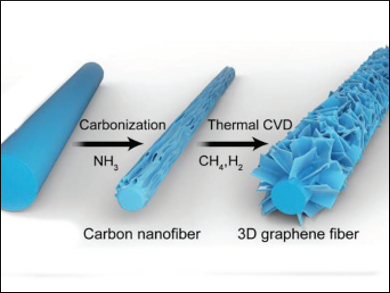Graphene sheets have a variety of useful physical and chemical properties. However, to retain these properties, agglomeration of the sheets has to be avoided. Arranging the sheets in 3D networks is a possible solution. However, networks synthesized using currently available methods often have low electrical conductivity and large pore sizes, which hampers their application.
Jie Yu, Harbin Institute of Technology, University Town, Shenzhen, China, and colleagues have developed a method for the synthesis of a 3D assembly of graphene sheets on a carbon fiber. This material has improved properties compared with currently available graphene sheet networks. The team used electrospinning to create nanofibers from the polymer polyacrylonitrile (PAN). The nanofibers were carbonized in NH3 to give carbon nanofibers with etched grooves. Thermal chemical vapor deposition in a mixture of CH4 and H2 was then used to grow graphene sheets on the carbon nanofibers (pictured).
The graphene sheets on the resulting 3D graphene fibers have fully exposed edges, which leads to properties such as superhydrophobicity and superoleophilicity. The fibers outperform previously available 3D graphene materials with regard to electrical conductivity and electromagnetic shielding. According to the researchers, the synthesis strategy could also be used to grow the graphene sheets on other substrates.
- 3D Graphene Fibers Grown by Thermal Chemical Vapor Deposition,
Jie Zeng, Xixi Ji, Yihui Ma, Zhongxing Zhang, Shuguang Wang, Zhonghua Ren, Chunyi Zhi, Jie Yu,
Adv. Mater. 2018.
https://doi.org/10.1002/adma.201705380

![Synthesis of [c2]Daisy Chains via Mechanochemistry](https://www.chemistryviews.org/wp-content/uploads/2025/04/202504_RotaxanesWithSolidStateMechanochemistry-125x94.png)

